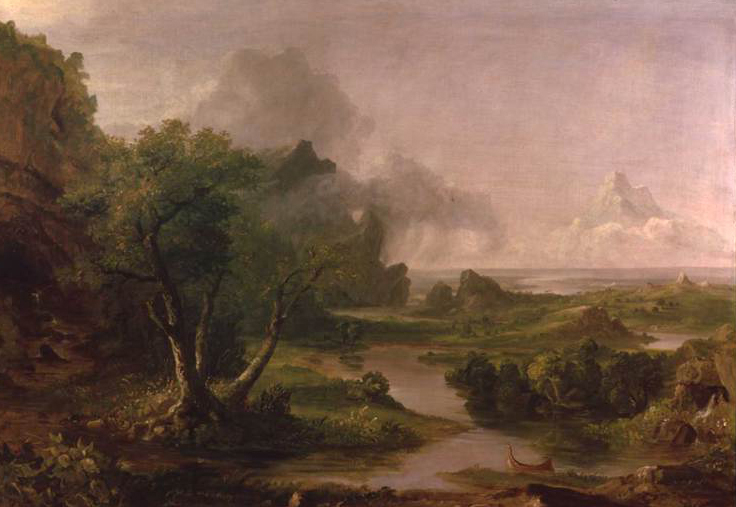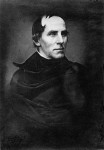
Thomas Cole
American, 1801-1848
The Meeting of the Waters, 1847 ca.
oil on canvas
51 x 75 3/4 in.
SBMA, Gift of Suzette Morton Davidson to the Preston Morton Collection
1979.19

Undated and mysterious photo of Cole.
“Nature has spread for us a rich and delightful banquet. Shall we turn from it? ... We are still in Eden.”
Thomas Cole
“I was overwhelmed with an emotion of the sublime, such as I have rarely felt... Over all, rocks, wood, and water, brooded the spirit of repose, and the silent energy of nature stirred the soul to its inmost depths”.
Thomas Cole, “Essay on American Scenery,” 1835
RESEARCH PAPER
Thomas Cole has been credited with founding American Landscape painting, and his followers formed the Hudson River School. The “Meeting on the Waters” was painted when he was well established and his skills were fully developed. It was found unfinished in his studio upon his death in 1848. When one looks at this landscape, one sees a peaceful moment. While many of Cole’s landscapes depict nature as vast and even terrifying, what was referred to as “sublime” at the time, this landscape appears more bucolic and soothing. One can see a small stream emerging on the left side from a dark cave, flowing down to the right to join a quiet stream that is in the foreground. The middle ground shows a tree and an inviting grassy bank. The sun is glowing through the clouds, and the water is calm enough to mirror the trees and bushes on the riverbank. While this picture appears to show nature untouched by man, there is a little boat that appears abandoned in the right foreground. In order to explore the significance of this painting, one must look at other works by the artist as well as his biography.
Thomas Cole was born in Lancashire, England, in 1801. By the time he was born, the town had been heavily polluted and decimated by industry, which shaped his perception of civilization’s destructive effects on nature. (National Gallery) At the age of seventeen he moved with his family to America and began working in Philadelphia as a wood engraver, then in the wallpaper manufacturing business with his father in Ohio. Unhappy with his trade, he set out to teach himself painting, receiving only rudimentary instruction from a traveling portrait artist. Most of his initial work was small and depicted peaceful rural settings.
Moving to New York City in spring 1825, Cole made a trip up the Hudson River to the eastern Catskill Mountains. His paintings based on his sketches in the Catskill Mountains finally brought him much needed attention and money. A city bookseller agreed to display the landscapes in his window. Colonel John Trumbull purchased one painting and brought Cole to the attention of various patrons, who began eagerly buying his work. This success allowed him to travel back to Europe and study the works of J.M.W. Turner and John Constable, two of the most important landscape painters in England. There, he learned to capture the allure of nature painted with much greater drama and scale.
Expanding from portraits and genre scenes, Cole turned to his love of nature and his deeply held religious beliefs for much of his inspiration. As many Christian artists and writers did at the time, he used his art to convey a moral lesson or religious inspiration. Cole’s landscapes focused on untouched wilderness and its awesome power, which was unique to the new world. He wrote in his essay on American scenery in 1835, "The most distinctive, and perhaps the most impressive, characteristic of American scenery is its wildness," he continued, ”It is the most distinctive because in civilized Europe the primitive features of scenery have long since been destroyed or modified.” (Cole, p. 7)
Even as Cole expanded his travels and subjects to include scenes in the White Mountains of New Hampshire, he aspired to what he termed a “higher style of landscape” that included narrative—painting that serves to fortify and instruct the viewer. He created the “Course of Empire”, a series of paintings that warn young America of the destruction and decay that follows greedy development. He painted other series of paintings in narrative style, but the series that is most evocative of the “Meeting of the Waters” is his series of four paintings entitled “The Voyage of Life”, painted in 1842. "The Voyage of Life" portrayed life as a pilgrimage which can be divided into four stages: childhood, youth, adulthood, and old age. He develops the narrative by using the river as a metaphor for a person’s journey through life. In each painting, the voyager is accompanied by a guardian angel as he travels in a boat on the River of Life. In childhood the infant glides from a dark cave into a small quiet stream. This represents an infant coming from a place we cannot know. The small stream is calm and protected, as early childhood appears to be. As a youth, the boy takes control of the boat and seems to envision earthly success as seen in the clouds. In manhood, the adult faces rough waters and a harrowing storm. Finally, the old man again sees his guardian angel and finds calm waters representing eternity. The landscape and river moves from being peaceful and protected for the young child, to being windy and treacherous for the man in adulthood.
With the same visual metaphors of life’s journey on a river in mind, one might wonder what Cole intended in his “Meeting of the Waters”. The landscape most resembles his depiction of youth, with water and land looking calm and inviting. There is a bend in the river with three trees, which were to symbolize the crosses of Calvary. The boat is on the shore as if waiting for someone or abandoned at the beginning of life’s journey. The water ahead, including the ocean, do not appear rough or intimidating but smooth and inviting. The ocean was to symbolize becoming one with the infinite. This landscape does not depict a brutal storm, or dangerous rapids. Had he reconsidered the bleak way that he had portrayed adulthood? Did he intend to paint a figure in the landscape, that he hadn’t finished? Was he reflecting on his own death? Could the boat washed up only a short distance from the cave represent a life cut short, for he had just lost an infant daughter? We can’t know exactly what Cole intended to convey with this unfinished painting, but one can be sure that he intended the viewer to contemplate a larger religious message than we might consider at first glance.
Prepared for the Santa Barbara Museum of Art Docent Council by Kim Carr-Howard, 2020.
BIBLIOGRAPHY
Avery, Kevin J. “Thomas Cole (1801–1848)” in Heilbrunn Timeline of Art History. New York: The Metropolitan Museum of Art, 2000–.
http://www.metmuseum.org/toah/hd/cole/hd_cole.htm
Cole, Thomas. "Essay on American Scenery" in American Monthly Magazine 1, (January 1836) 1-12.
Munson Williams Proctor Arts Institute (MWPAI), Utica, New York. “Thomas Cole’s ‘The Voyage of Life’.”
https://www.mwpai.org/view/collections/thomas-coles-the-voyage-of-life/
National Gallery, London. Curator’s Introduction to “Thomas Cole: Eden to Empire.”
https://www.youtube.com/watch?v=BRFT1RBXrUQ.
Sweeney, J. Gray. “Thomas Cole, 1801-1848” in “The Presto Morton Collection of American Art”. Santa Barbara: Santa Barbara Museum of Art, 1981. Pp. 82-89.
SBMA CURATORIAL LABELS
It is thought that this might be one of the last paintings done by Cole, who tragically died from pneumonia at the age of 47. It may be unfinished, since earlier allegorical landscapes of the pilgrim’s progress typically included tiny figures and have a greater level of detail. Whatever the case, this is a ravishing example of Cole’s mature landscape style and his ability to infuse nature with a divine sublimity that his audience readily recognized. While there are no supernatural phenomena in this sprawling landscape, Cole intended for its natural iconography to be read symbolically; for example, the three trees at the center left are emblematic of the three crosses of Calvary, thereby hinting at the pilgrim’s possibility of immortality through Christ’s redemption. The opening lines of the twenty-third Psalm may have been the textual inspiration for this extraordinary painting:
The Lord is my shepherd: I shall not want.
He maketh me to lie down in green pastures:
He leadeth me beside the still waters.
- Ridley-Tree Reopening, 2021
Left unfinished at the time of his premature death in 1848, The Meeting of the Waters reflects Cole’s embrace of religious themes in the final decade of his career and synthesizes aspects of the symbolism with which he had long imbued his landscapes. Marking life’s mysterious origins, the painting incorporates at left the deep chasm seen in Cole’s earlier The Voyage of Life: Childhood (1842), as well as the serpentine river and storm clouds of his famed View from Mount Holyoke, Northampton, Massachusetts after a Thunderstorm—The Oxbow (1836), a work in which Cole masterfully combined several passages of terrain in a single canvas. Centered on the convergence of a small creek and a larger river, Meeting of the Waters narrates the twists and turns of the life cycle as a progression downstream, offering a parade of the picturesque, the sublime, and the beautiful on which Cole drew in the creation of his allegorical landscapes.
- SBMA Gallery Label, 2012
